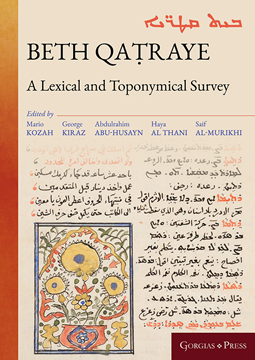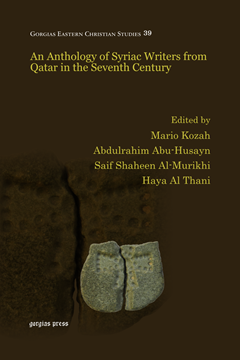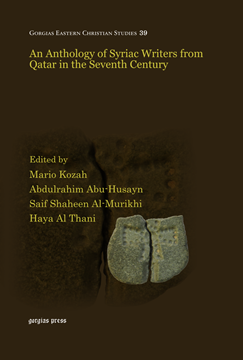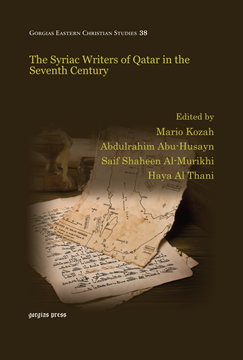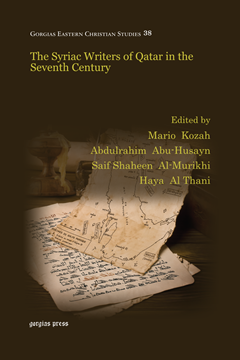Haya Al Thani
Beth Qaṭraye
A Lexical and Toponymical Survey
By Dr Mario Kozah, George Anton Kiraz, Prof Abdulrahim Abu-Husayn, Haya Al Thani & Saif Shaheen Al-Murikhi
Series: Gorgias Eastern Christian Studies 58
ISBN: 978-1-4632-4139-1
This volume presents and analyzes information on the pre-Islamic and early Islamic historical geography and toponyms of the Beth Qaṭraye region as well as newly discovered vocabulary from a language referred to as Qaṭrāyīth (“in Qatari”) used by its inhabitants.
$55.00 (USD)
The Syriac and Arabic Lexicon of Hasan Bar Bahlul (Olaph-Dolath)
Prepared by Dr Mario Kozah, George Anton Kiraz, Haya Al Thani, Prof Abdulrahim Abu-Husayn & Saif Shaheen Al-Murikhi; Introductory Material Translated by Samuel Barry
ISBN: 978-1-4632-4101-8
Beth Qaṭraye was an important cultural, linguistic and religious crossroads in the pre- and early Islamic periods. In this reissue of a facsimile edition of Duval’s edition of Bar Bahlul’s lexicon, Duval’s Latin introductory material has been translated into English by Samuel Barry.
$55.00 (USD)
The Syriac and Arabic Lexicon of Hasan Bar Bahlul (He-Mim)
Prepared by Dr Mario Kozah, George Anton Kiraz, Haya Al Thani, Prof Abdulrahim Abu-Husayn & Saif Shaheen Al-Murikhi
ISBN: 978-1-4632-4103-2
Beth Qaṭraye was an important cultural, linguistic and religious crossroads in the pre- and early Islamic periods. In this reissue of a facsimile edition of Duval’s edition of Bar Bahlul’s lexicon, Duval’s Latin introductory material has been translated into English by Samuel Barry.
$35.00 (USD)
The Syriac and Arabic Lexicon of Hasan Bar Bahlul (Nun-Taw)
Prepared by Dr Mario Kozah, George Anton Kiraz, Haya Al Thani, Prof Abdulrahim Abu-Husayn & Saif Shaheen Al-Murikhi
ISBN: 978-1-4632-4113-1
Beth Qaṭraye was an important cultural, linguistic and religious crossroads in the pre- and early Islamic periods. In this reissue of a facsimile edition of Duval’s edition of Bar Bahlul’s lexicon, Duval’s Latin introductory material has been translated into English by Samuel Barry.
$35.00 (USD)
The Syriac and Arabic Lexicon of Hasan Bar Bahlul (set)
Prepared by Dr Mario Kozah, George Anton Kiraz, Haya Al Thani, Prof Abdulrahim Abu-Husayn & Saif Shaheen Al-Murikhi; Introductory Material Translated by Samuel Barry
ISBN: 978-1-4632-4120-9
Beth Qaṭraye was an important cultural, linguistic and religious crossroads in the pre- and early Islamic periods. In this reissue of a facsimile edition of Duval’s edition of Bar Bahlul’s lexicon, Duval’s Latin introductory material has been translated into English by Samuel Barry.
From $35.00 (USD)
An Anthology of Syriac Writers from Qatar in the Seventh Century
Series: Gorgias Eastern Christian Studies 39
ISBN: 978-1-4632-0545-4
The Syriac writers of Qatar have not received the scholarly attention that they deserve in the last half century. This anthology seeks to redress such an underdevelopment by providing new material in English translation with accompanying Syriac and Garshuni editions to encourage further research in the sub-field of Beth Qatraye studies. It includes the work of some of the most prominent scholars in this field.
$25.00 (USD)
An Anthology of Syriac Writers from Qatar in the Seventh Century
Series: Gorgias Eastern Christian Studies 39
ISBN: 978-1-4632-0547-8
The Syriac writers of Qatar have not received the scholarly attention that they deserve in the last half century. This anthology seeks to redress such an underdevelopment by providing new material in English translation with accompanying Syriac and Garshuni editions to encourage further research in the sub-field of Beth Qatraye studies. It includes the work of some of the most prominent scholars in this field.
$110.00 (USD) $66.00 (USD)
The Syriac Writers of Qatar in the Seventh Century
Series: Gorgias Eastern Christian Studies 38
ISBN: 978-1-4632-0524-9
The Syriac writers of Qatar themselves produced some of the best and most sophisticated writing to be found in all Syriac literature of the seventh century, but they have not received the scholarly attention that they deserve in the last half century. This volume seeks to redress this underdevelopment by setting the standard for further research in the sub-field of Beth Qatraye studies.
$157.00 (USD) $94.20 (USD)
The Syriac Writers of Qatar in the Seventh Century
Series: Gorgias Eastern Christian Studies 38
ISBN: 978-1-4632-0355-9
The Syriac writers of Qatar themselves produced some of the best and most sophisticated writing to be found in all Syriac literature of the seventh century, but they have not received the scholarly attention that they deserve in the last half century. This volume seeks to redress this underdevelopment by setting the standard for further research in the sub-field of Beth Qatraye studies.
$25.00 (USD)

